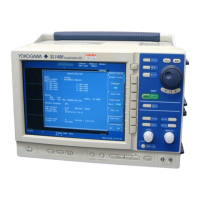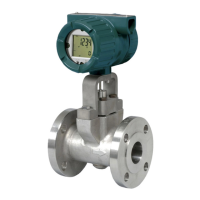IM 12D03D02-01E
5-5
5. Maintenance
* Before calibrating the meter with standard solution, check that the electrode is clean. If stains
are found, clean the electrode rst. Also check that the cover (of general-purpose sensor) and
outer electrode (of sensor for high purity water measurement) are secure.
Cell constant is aected by stains or loose cover.
When calibrating, ensure that measuring range is set so that you can enter conductivity to as
many digits as possible. For example, in the table above, the conductivity of standard solution
C at 25°C is 1408.8. If the meter is set to autorange, or to a manual range of 0 to 2.000 mS/
cm, you could set this as 1.409 (four digits). However if the range were set to 0 to 200.0
mS/cm, you could only enter conductivity value as 1.4 (only two digits accuracy, which is
inadequate for calibration with standard solution.
Before calibrating the meter with standard solution
Check and set the following items before calibrating the meter with standard solution.
(1) Check sensor for stains
Check that there are no stains on the sensor. Also check that the meter cover
(for general-purpose sensor) or outer electrode (for sensor for high purity water
sensor) are not loose.
(2) Setting temperature coecients
When the meter is calibrated with a NaCl solution, set a temperature coecient
(indicated by “NaCl”) for NaCl solution. When it is calibrated with a KCl standard
solution, set a temperature coecient of 0.00 (%/°C).
(3) Standard solution temperature
For a NaCl standard solution, check that the standard solution temperature is in
the range 25°C ±10°C.
For a KCl standard solution, stabilize its temperature at 25°C ±1°C or 18°C ±1°C.
If it is dicult to maintain the above temperatures, set the temperature coecient
of KCl standard solution in the meter. To nd the temperature coecient, refer
to table 5.2 above and to Section 7.3, “Temperature Compensation and Finding
Temperature Compensation Coecient.”

